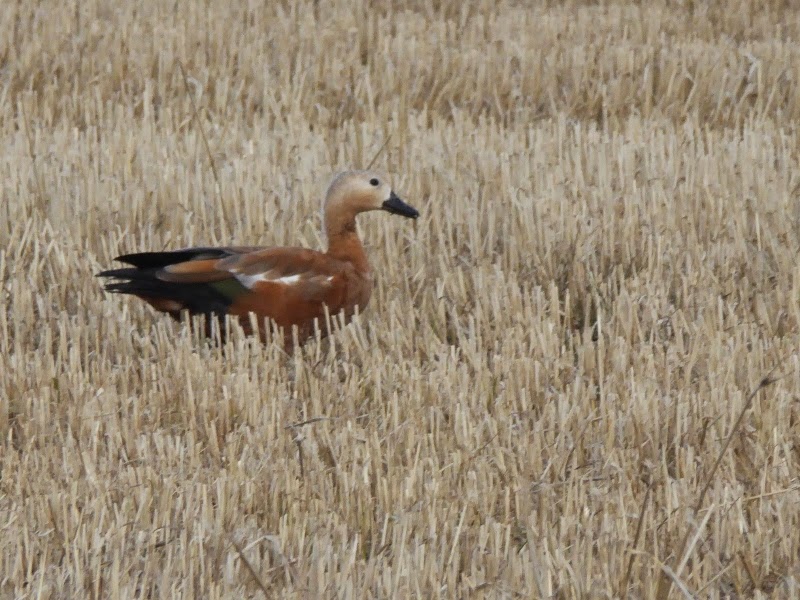And so at 04:45hrs on September 15th the alarm clock sounded and off I headed on the train to Penzance for the 09:15hrs crossing on the Scillonian III ferry to St.Marys. Leaving the harbour on time and the sun was shining between the gaps in the clouds but as the day progressed the cloud thickened and it remained grey and overcast. There was also a stiff Easterly breeze and so the sea was choppy but the crossing wasn't too rough and provided some fantastic sightings.
The Egyptian House, Penzance
We passed a small fishing boat not long after leaving the harbour and on scanning the water behind the boat there were a few gulls loafing around and I had a very brief view of a shearwater taking off from the water before flying off and out of sight across the front of the boat. It appeared long winged and uniformly brown and was probably a sooty shearwater but I couldn't be sure and I couldn't refind it. My attention was also distracted by a small bird fluttering over the waves which turned out to be a storm petrel which gave some nice views as it flew away from the boat. Not a bad start although a little frustrating.Heading along the Cornish coast towards Lands End and birds were everywhere - gannets, Manx shearwaters, shags (including a very pale juvenile that looked very red throated diver-y from a distance), kittiwakes (adults in winter plumage with black smudges on their heads and 1 juvenile), 2 juvenile Commic terns (distant views), great black backed-, lesser black backed- and herring gulls and 2 probable Balearic shearwaters (distant views again). Another storm petrel was also seen close to the boat in its characteristic fluttering and dipping flight over the water but as we passed Lands End the seabird sightings dwindled and eventually stopped. However between Lands End and The Scillies I did see a flyover goldfinch and 4 pied wagtails heading towards The Scillies and a kestrel low over the waves heading towards Land End along with 2 red admirals.
I also had some cetacean sightings with the best being 2 harbour porpoise, an adult with a calf, which passed quite closely alongside the boat with the calf showing very well on surfacing as it raised its head quite high out of the water, presumably to watch the boat going by. I also had some brief fin views of some common dolphins and later some brief fin views of bottle nose dolphins (larger and with a blue hue to them) and while queueing for a cup of tea in the café and looking out of the porthole I saw 2 common dolphins leaping out of the water and heading towards the boat before being lost from sight.
The Scillies were looking stunning as usual despite the grey skies and strong breeze. I had planned to visit Tresco as some good birds had been reported from there but with a greenish warbler having been reported on St.Marys the previous day I decided to stay on St.Marys - needless to say I didn't see the warbler!
Scillies Mega! (Telegraph pole ornament)
The Scillonian III in St.Marys Harbour
St.Marys Harbour on a grey and breezey day
Birding was heavy going in the cool, overcast conditions and the strong Easterly. Highlights were a spotted flycatcher, 2 whitethroat, 2 willow warbler (1 seen and 1 heard singing), a kestrel hovering over the fields, a peregrine flying over with a small bird in its talons, swallows everywhere with 1 sand martin, wheatears everywhere with many being quite tame, Sandwich terns fishing offshore and a 1st winter Mediterranean gull flying by the ferry as we headed back to Penzance. A few speckled wood and red admirals were also flitting about in more sheltered spots.
Wheatear
After such an eventful ferry crossing from Penzance I was looking forward to the return crossing but the light was poor and the sea choppier and the only sea mammal I saw was a seal poking its snout out of the water as we left St.Marys harbour. Again there were very few seabird sightings between The Scillies and Lands End but as we approached the Cornish coast birds began to appear. A great skua was seen flying across the back of the boat before landing on the sea along with gannets, gulls and Manx shearwaters and as we neared Lands End 10 ringed plover flew over the boat heading out to sea. A raft of shearwaters was resting on the sea and as we sailed through them they all scattered and I picked out a Balearic shearwater - noticeably larger and paler brown than the very dark looking Manx and with dirty looking underparts compared to the white of Manx. As we sailed on we disturbed more rafts and feeding flocks of shearwaters and I found at least 2 more Balearics amongst the Manx with 1 bird seen very well alongside the boat as it flew past, being much bigger bodied than the Manx and with noticeably paler upperparts. A juvenile Commic tern was also seen and as we approached Penzance harbour I had a distant and brief flight view of a long winged, uniform brown looking shearwater again before it landed on the sea - the sooty shearwater again? Very frustrating!And so it had been an exhausting day (I didn't get home until 22:45hrs) but it had been a great day out and one I will be doing again. The weather conditions had resulted in some poor birding on The Scillies but some fantastic sightings on the ferry crossings, the journey back being especially magical along the coast between Lands End and Penzance as the light began to fade and shearwaters were flying around all over the place. Life doesn't get much better than that.








































.jpg)


